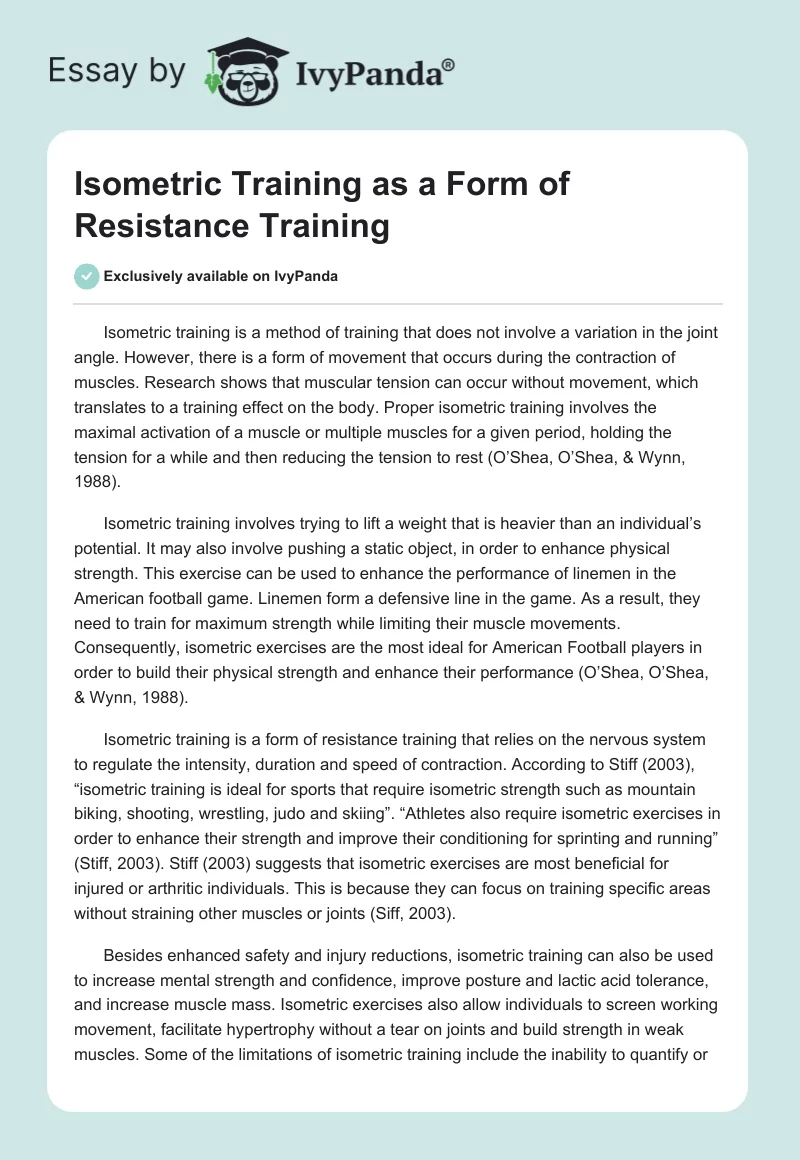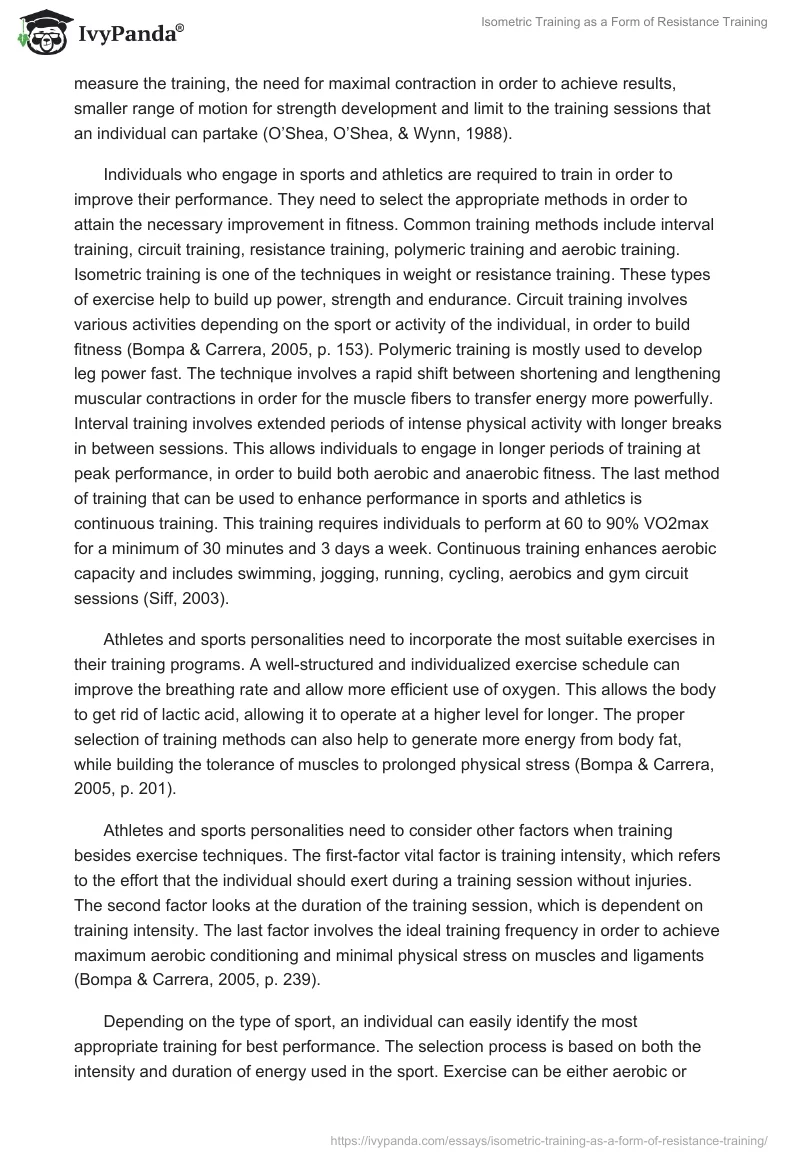Isometric training is a method of training that does not involve a variation in the joint angle. However, there is a form of movement that occurs during the contraction of muscles. Research shows that muscular tension can occur without movement, which translates to a training effect on the body. Proper isometric training involves the maximal activation of a muscle or multiple muscles for a given period, holding the tension for a while and then reducing the tension to rest (O’Shea, O’Shea, & Wynn, 1988).
Isometric training involves trying to lift a weight that is heavier than an individual’s potential. It may also involve pushing a static object, in order to enhance physical strength. This exercise can be used to enhance the performance of linemen in the American football game. Linemen form a defensive line in the game. As a result, they need to train for maximum strength while limiting their muscle movements. Consequently, isometric exercises are the most ideal for American Football players in order to build their physical strength and enhance their performance (O’Shea, O’Shea, & Wynn, 1988).
Isometric training is a form of resistance training that relies on the nervous system to regulate the intensity, duration and speed of contraction. According to Stiff (2003), “isometric training is ideal for sports that require isometric strength such as mountain biking, shooting, wrestling, judo and skiing”. “Athletes also require isometric exercises in order to enhance their strength and improve their conditioning for sprinting and running” (Stiff, 2003). Stiff (2003) suggests that isometric exercises are most beneficial for injured or arthritic individuals. This is because they can focus on training specific areas without straining other muscles or joints (Siff, 2003).
Besides enhanced safety and injury reductions, isometric training can also be used to increase mental strength and confidence, improve posture and lactic acid tolerance, and increase muscle mass. Isometric exercises also allow individuals to screen working movement, facilitate hypertrophy without a tear on joints and build strength in weak muscles. Some of the limitations of isometric training include the inability to quantify or measure the training, the need for maximal contraction in order to achieve results, smaller range of motion for strength development and limit to the training sessions that an individual can partake (O’Shea, O’Shea, & Wynn, 1988).
Individuals who engage in sports and athletics are required to train in order to improve their performance. They need to select the appropriate methods in order to attain the necessary improvement in fitness. Common training methods include interval training, circuit training, resistance training, polymeric training and aerobic training. Isometric training is one of the techniques in weight or resistance training. These types of exercise help to build up power, strength and endurance. Circuit training involves various activities depending on the sport or activity of the individual, in order to build fitness (Bompa & Carrera, 2005, p. 153). Polymeric training is mostly used to develop leg power fast. The technique involves a rapid shift between shortening and lengthening muscular contractions in order for the muscle fibers to transfer energy more powerfully. Interval training involves extended periods of intense physical activity with longer breaks in between sessions. This allows individuals to engage in longer periods of training at peak performance, in order to build both aerobic and anaerobic fitness. The last method of training that can be used to enhance performance in sports and athletics is continuous training. This training requires individuals to perform at 60 to 90% VO2max for a minimum of 30 minutes and 3 days a week. Continuous training enhances aerobic capacity and includes swimming, jogging, running, cycling, aerobics and gym circuit sessions (Siff, 2003).
Athletes and sports personalities need to incorporate the most suitable exercises in their training programs. A well-structured and individualized exercise schedule can improve the breathing rate and allow more efficient use of oxygen. This allows the body to get rid of lactic acid, allowing it to operate at a higher level for longer. The proper selection of training methods can also help to generate more energy from body fat, while building the tolerance of muscles to prolonged physical stress (Bompa & Carrera, 2005, p. 201).
Athletes and sports personalities need to consider other factors when training besides exercise techniques. The first-factor vital factor is training intensity, which refers to the effort that the individual should exert during a training session without injuries. The second factor looks at the duration of the training session, which is dependent on training intensity. The last factor involves the ideal training frequency in order to achieve maximum aerobic conditioning and minimal physical stress on muscles and ligaments (Bompa & Carrera, 2005, p. 239).
Depending on the type of sport, an individual can easily identify the most appropriate training for best performance. The selection process is based on both the intensity and duration of energy used in the sport. Exercise can be either aerobic or anaerobic. Aerobic exercises last longer than anaerobic ones. While aerobic exercises enhance the delivery of oxygen to muscles, anaerobic exercises improve one’s tolerance to lactic acid. A proper training program requires the athlete to balance between the two exercises. With isometric training, athletes and trainers can advance their power and increase their sporting performance (Siff, 2003). However, it should be used as a supplement to dynamic training, since the sport is dynamic as well and in order to combine aerobic and anaerobic exercises appropriately.
References
Bompa, T., & Carrera, M. (2005). Periodization training for sports (2nd ed.). Champaign, IL: Human Kinetics.
O’Shea, P., O’Shea, K., & Wynn, B. (1988). Strength Development: Functional Isometric Lifting Part I: theory. National Strength and Conditioning Association Journal, 9(6), 44-51.
Siff, M. (2003). Triphasic Muscle Action. Facts and Fallacies of Fitness, 108-109.


